Review: LensCoat RainCoat Pro |
Product Description: Rain cover designed to protect DSLR camera and lens - on or off a tripod - in rainy or snowy conditions.
Full Product Name(s): LensCoat RainCoat Standard and LensCoat RainCoat Pro
The RainCoat Standard fits camera-lens combinations with lenses as large as a typical 400mm f5.6. The RainCoat Pro is designed for camera-lens combinations with larger telephoto and super-telephoto lenses attached, from 300mm f2.8 lenses up to 800mm f5.6 lenses.
Price: RainCoat Standard $79.95; RainCoat Pro $99.95
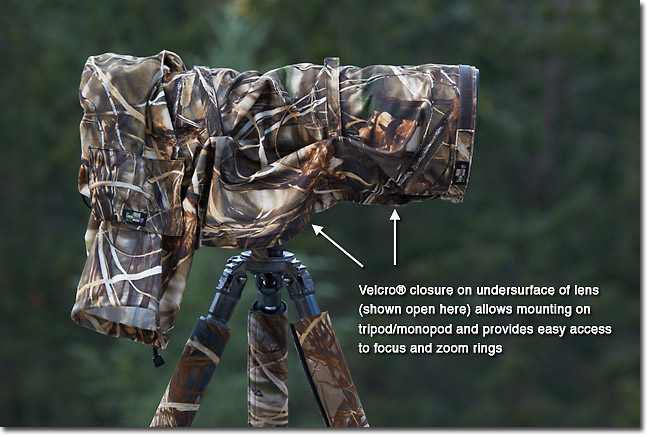
Product Features
- Versatile - no dedicated eyepiece needed
- Constructed from lightweight waterproof and breathable poly tricot material
- Tape-sealed seams
- Thin rubber coating around end of hood section for solid, non-slip grip
- Integrated pocket with foldaway arm sleeve (for camera control access)
- Extended length Velcro bottom closure for tripod/monopod access or to access your lens's focus or zoom ring
- Adjustable draw-string style rear access (with cord lock) for easy camera access and view of LCD screen
- Additional 8" (20 cm) extension for 600-800mm lenses (Pro model only)
- Length (Pro model): 30.5" (77.5 cm) plus 8" (20 cm) with long lens extension
- Length (Standard model): 20.5" (52 cm)
- Weight (Pro model): 8.6 oz (244 g) plus add 2.4 oz (68 g) for long lens extension
- Weight (Standard model): 6.4 oz (181 g)
- Mesh storage and transportation pouch included
Executive Summary
The LensCoat RainCoat Pro is a versatile rain cover that offers a good blend of moisture protection, breathability, convenience and ease-of-use, and value for the money. Lightweight and compact, it easily justifies the room in occupies in even the most accessory-stingy nature photographer's camera bag or pack.
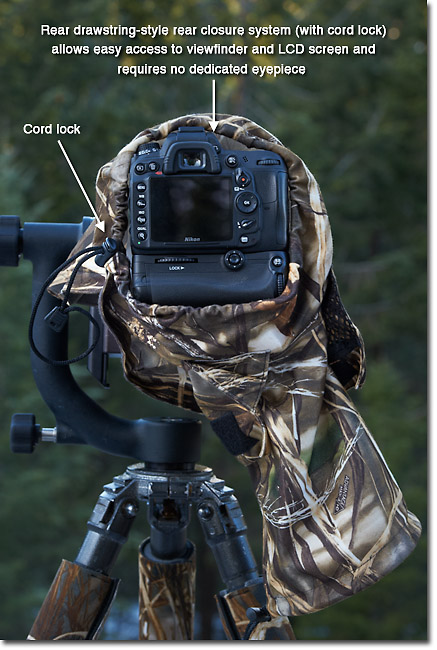
The Full Meal Deal!
As a full-time wildlife photographer who spends up to two months per year shooting and leading photo tours in the Great Bear Rainforest of British Columbia, rain covers are an absolutely critical piece of my gear. Not surprisingly, I like to keep on top of all developments and product introductions in the category of "gear protection" - not only for my own sake, but also for the benefit of my clients as I only want to recommend gear to them that actually works! So when I was asked to test and review the RainCoat Pro from LensCoat I was more than happy to do so. And, I was probably better positioned to compare this product than some others – over the years I have seen EVERYTHING tried as rain protection for cameras and lenses - from slightly modified green garbage bags to many home-made concoctions through to the highest-priced commercial options.
A. My Testing Regime
I used the RainCoat Pro over a period of almost 3 months during my testing period. This included a two-week stint in the Great Bear Rainforest in September/October of 2011. During this time in the Great Bear Rainforest we had rain almost daily and we shot in it almost daily. I used the RainCoat Pro interchangeably and in almost equal proportions to my standing favourite rain cover - an AquaTech Sport Shield. I also loaned the RainCoat Pro to two photographers who had little-to-no experience with rain covers and asked them simply to tell me what they thought of it (and I told them virtually nothing about it). During this time in the Great Bear Rainforest we did have several shooting sessions where we were standing exposed to the rain for over 3 hours continuously (we - and our gear - got POURED on!).
Following my time in the Great Bear Rainforest I also had the chance to try the RainCoat Pro while shooting during both wet snowstorms (at around the freezing point) and sub-zero (Celcius) "dry" snowstorms.
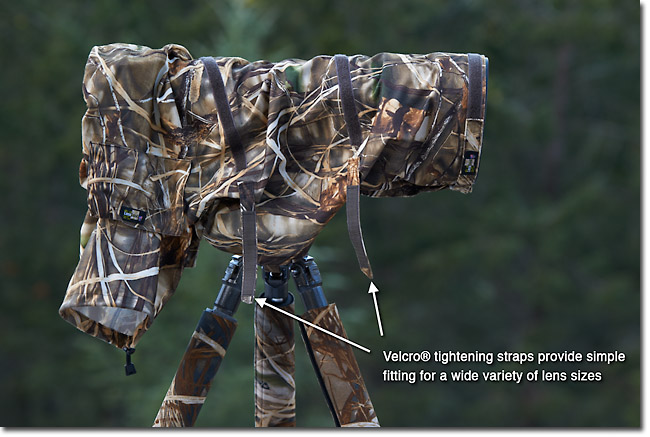
B. My Thoughts on the RainCoat Pro
1. Gear Protection. Like a rain coat designed for active wear, a good rain cover must balance absolute waterproofness with breathability. A barrier completely non-permeable to water (such as a green garbage bag) may protect a camera/lens well in a brief downpour. But if a camera is left in the rain for long periods of time condensation soon starts to build up inside of the cover. This is absolutely unavoidable - some of the moisture comes from the photographer's hands (or gloves) that normally enter and exit the rain protection system multiple times and some simply comes in as humid air whenever the system is opened up (which it has to be if one is going to use the camera). The LensCoat RainCoat Pro was NOT 100% impervious to rain - after multiple hours in the rain a very small amount of moisture DID leak through the fabric. However, the instant the rain subsided the moisture was quick to leave the system and the fabric rapidly dried. I felt that the RainCoat Pro struck a very good balance between keeping the bulk of the moisture (i.e., rain drops) out while letting water vapor escape. Additionally, the long Velcro closure along the underside of the lens (see figure 1) could be left open and further enhance breathability and ventilation.
The RainCoat Pro has a rear "closure" system that is very simple and little more than a drawstring system (see figure 2). The huge advantage to this is that virtually all DSLR's - regardless of size or eyepiece style - can be used with this system. In contrast, some of the high-end competing products (such as AquaTech Sport Shields and Think Tank Photo's Hydrophobia rain covers) have dedicated eyepieces and their covers have neoprene openings in the rear that stretch over these eyepieces. If one is shooting in driving rain that is coming from BEHIND the photographer then both AquaTech's and Think Tank Photo's rain covers DO offer slightly better protection. But, this comes at the expense of versatility - if you use multiple camera bodies EACH has to have a dedicated eyepiece (and the eyepieces often differ between camera bodies - my Nikon D3S has round eyepieces while my D7000 has square ones). While the issue of needing a dedicated eyepiece may seem trivial, try lending your AquaTech or Think Tank Photo rain cover to a friend (or client) who is using the "other" brand from you! But switching between camera bodies (of any brand) - or lending the cover to a friend/client - is NO issue with the LensCoat RainCoat (photo tour operators who run tours in areas that experience rain should be taking note of this point).
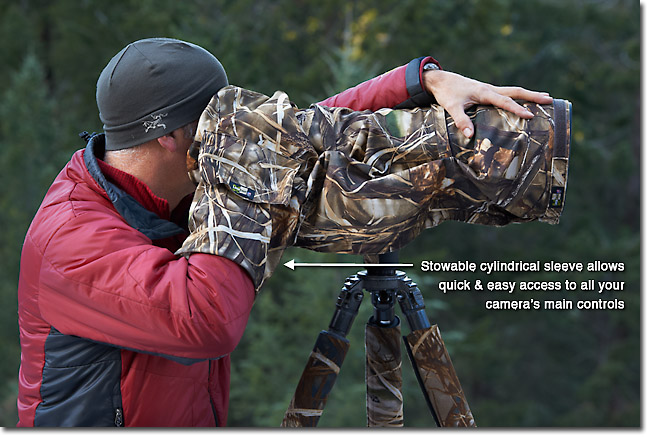
2. Convenience/Ease of Use. Maybe I'm just lazy, but if it takes me five minutes to put a rain cover on there's a good chance that I just won't do it in a light drizzle (or, more problematically, my camera will already be wet if I'm caught in an unexpected downpour). The very first time I put my LensCoat RainCoat on it took me less than one minute - and this was while I was "figuring it out on the fly". Bottom line here: the RainCoat is a well-designed product that it simple to put on, simple to take off, and, with its Velcro closures and "tighteners", simple to adjust to a myriad of different sized lenses (see figure 3). Even the access sleeve for the user's right hand (see figure 4) - which bears no zippers or straps - is simple and easy-to-use (and packs away into a small pocket). And, for those concerned about the bulk and weight of accessories they carry into the field, the RainCoat Pro is significantly lighter and packs into a smaller space than many of its competitors.
3. Some Unexpected Bonuses. Over time I discovered at least two "bonuses" that hadn't occurred to me when I first started using the RainCoat. First, the RainCoat comes with a mesh storage and transportation pouch (see figure 5). This seemed like a nice extra when I got the RainCoat but I didn't think much about the value of it being made of a wide mesh. That is, until I got back from the Great Bear Rainforest and promptly forgot that I had packed away the RainCoat WET and left it that way for two weeks. Fortunately, because the mesh bag was totally breathable, my RainCoat had fully dried while packed tightly in the bag (and there was no sign of mold or mildew). Well kids, I don't recommend doing this at home, but if you DO, it's nice to know that the cover can dry out while packed away!
Second, the RainCoat works very well in below freezing temperatures - the soft poly tricot material does not stiffen up or freeze. That can't be said for some of the "clear plastic" rain covers offered by other manufacturers (that shall remain nameless).
4. Stacking up Against the Competition? A quick online search will reveal literally dozens of models of rain covers from various manufacturers starting at under $20.00 and ending up at over $200 (once dedicated eyepieces are added in). I've seen virtually all of them used (with varying success) in the field. And, until I tested the RainCoat Pro I could only recommend two brands: AquaTech's Sport Shields and Think Tank Photo's Hydrophobia. Now, I can add a third brand to my list of recommended rain covers: LensCoat's RainCoat (both Standard and Pro). I do believe that because of their dedicated eyepieces and rear closure systems the rain covers from AquaTech and Think Tank Photo offer slightly better rain protection in extreme conditions. But, the trade-off is versatility - by utilizing a rear closure system that avoids the need for a special dedicated eyepiece the RainCoat is both easier to use and fits far more cameras. In short it's simply more versatile. And, considerably less costly!
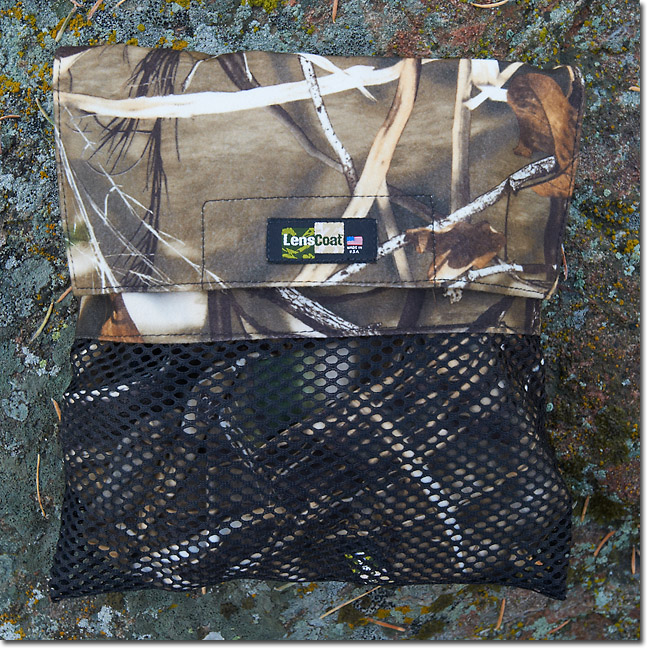
5. What the Other Testers Thought. The two photographers I loaned the LensCoat RainCoat Pro to found it easy-to-use and thought it offered good rain protection. After using the RainCoat - and after seeing the two leading competing products in use - one of the two photographers told me he was going to order a LensCoat RainCoat Pro as soon as he returned home.
6. Who Should Buy It? Any nature photographer who may occasionally find themselves caught in a rainstorm or shower OR who might take only the occasional trip to extremely rainy locations (like the Great Bear Rainforest!). So, in other words, the vast majority of nature photographers would LOVE this product!
7. Do I Recommend It? Yes.
8. Will I Use It? Yes - and no. If I'm being 100% honest, I won't be leaving my AquaTech Sport Shields at home in favour of the LensCoat RainCoat when I venture into the Great Bear Rainforest next May. BUT, if you look into my camera backpack any other time of year you'll find only ONE rain cover in it - my lightweight and easily packable LensCoat Raincoat. And one more thing - while I won't be leaving my AquaTech at home, I WILL be taking my LensCoat RainCoat into the Great Bear Rainforest next year as well. Why? Because it's the absolute best option as a quality loaner when I have a client show up with no rain cover. And, as a matter of fact, I may just have to purchase a second one - for that other client that's bound to show up sans rain cover if I only have one loaner!
Comments on NPN nature photography equipment reviews? Send them to the editor. NPN members may also log in and leave their comments below.
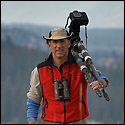 Brad Hill, is a full-time nature photographer from the southern Columbia Valley of British Columbia, Canada, with a concentration on the nature and wildlife of North America and, in particular, western Canada. Brad is also the moderator for the fauna gallery here on NPN.
Brad Hill, is a full-time nature photographer from the southern Columbia Valley of British Columbia, Canada, with a concentration on the nature and wildlife of North America and, in particular, western Canada. Brad is also the moderator for the fauna gallery here on NPN.
To see more of Brad's photography, visit his webiste at www.naturalart.ca.